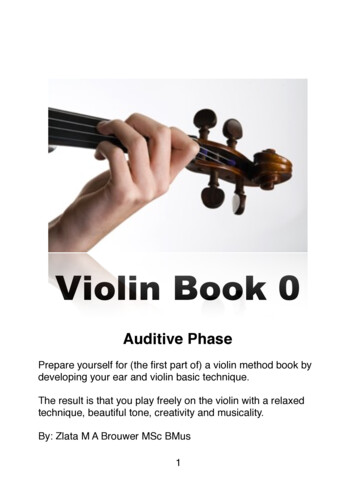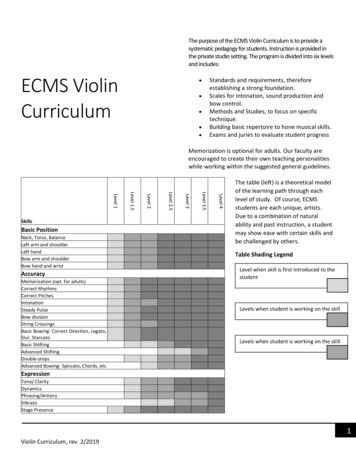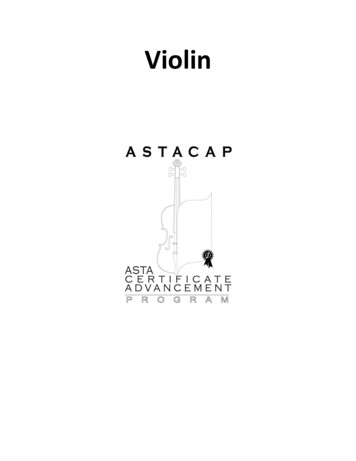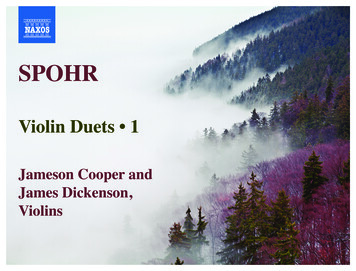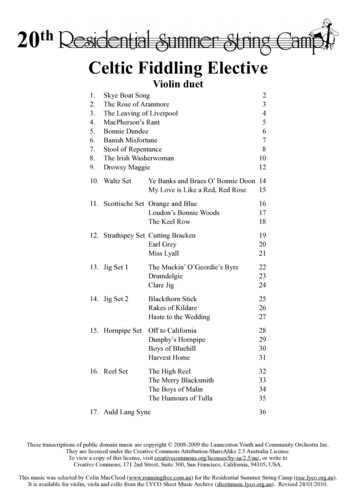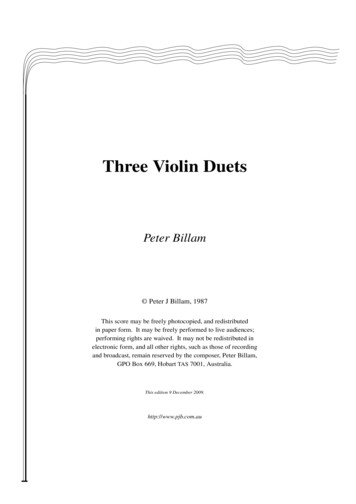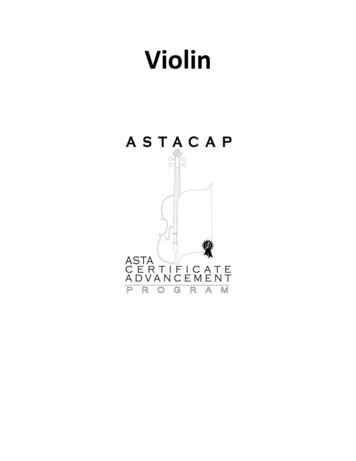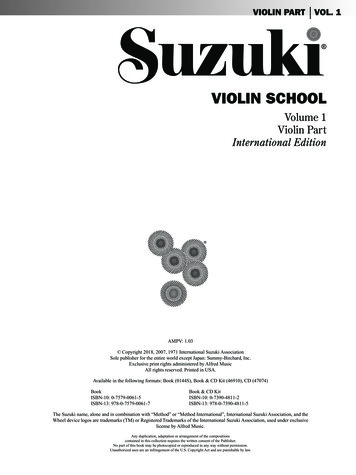
Transcription
VIOLIN PARTI VOL. 1VIOLIN SCHOOLVolume 1Violin PartInternational Edition AMPV: 1.03 Copyright 2018, 2007, 1971 International Suzuki AssociationSole publisher for the entire world except Japan: Summy-Birchard, Inc.Exclusive print rights administered by Alfred MusicAll rights reserved. Printed in USA.Available in the following formats: Book (0144S), Book & CD Kit (46910), CD (47074)BookISBN-10: 0-7579-0061-5ISBN-13: 978-0-7579-0061-7Book & CD KitISBN-10: 0-7390-4811-2ISBN-13: 978-0-7390-4811-5The Suzuki name, alone and in combination with “Method” or “Method International”, International Suzuki Association, and theWheel device logos are trademarks (TM) or Registered Trademarks of the International Suzuki Association, used under exclusivelicense by Alfred Music.Any duplication, adaptation or arrangement of the compositionscontained in this collection requires the written consent of the Publisher.No part of this book may be photocopied or reproduced in any way without permission.Unauthorized uses are an infringement of the U.S. Copyright Act and are punishable by law.
INTRODUCTIONMethodTMEINLEITUNGThis volume is part of the worldwide Suzukiof teaching.The companion recording should be used along with each volume.Dieses Heft ist Teil der weltweit verbreiteten „Suzuki-Methode“. Diedazugehörende Aufnahme sollte stets mit verwendet werden.For the parent: Credentials are essential for any Suzuki teacheryou choose. We recommend that you ask your teacher for his or hercredentials, especially relating to training in the Suzuki Method.The Suzuki Method experience should foster a positive relationshipamong teacher, parent and child. Choosing the right teacher is of theutmost importance.Für die Eltern: Jede(r) Suzuki-Lehrer(in) sollte eine entsprechendeAusbildung nachweisen können. Wir empfehlen Ihnen deshalb, IhreLehrperson nach ihrer Suzuki-Ausbildung zu fragen. Der SuzukiUnterricht sollte eine gute Beziehung zwischen Eltern, Kind undLehrperson fördern. Die Wahl des richtigen Lehrers bzw. der richtigenLehrerin ist deswegen von höchster Bedeutung.For the teacher: To be an effective teacher ongoing study and educationare essential. Each Regional Suzuki Association provides Teacher Trainingand Teacher Development for members. It is strongly recommended thatall teachers be members of their regional or country associations.Für die Lehrer: Um erfolgreich unterrichten zu können, ist ständigeWeiterbildung unabdingbar. Jede Nationale Suzuki-Gesellschaft bietetMöglichkeiten zur Aus- und Weiterbildung an. Es ist sehr zu empfehlen,dass alle Suzuki-Lehrer ihrer Nationalen Suzuki-Vereinigung angehören.To obtain more information about your Regional Suzuki Association,contact the International Suzuki Association: www.internationalsuzuki.orgFür weitere Informationen: www.internationalsuzuki.orgThis revised edition of the Suzuki Violin School was made by andis a continuing cooperative effort of the International Suzuki ViolinCommittee using Dr. Shinichi Suzuki’s texts and methodology.INTRODUCTIONCes matériaux appartiennent à la méthode Suzuki telle qu’elle estenseignée dans les différents pays du monde. Les enregistrementsaccompagnants doivent être utilisés en combinaison avec cettepublication.Pour les parents: Les qualifications sont essentielles dans le choix duprofesseur. Aussi nous vous recommandons de demander au professeurquels sont ses diplômes et notamment ceux qui ont trait à l’enseignementde la méthode Suzuki. L’apprentissage par la méthode Suzuki doit êtreune expérience positive, où il existe une relation épanouissante entrel’enfant, le parent et le professeur. Le choix du bon professeur est dès lorsd’une importance cruciale.Pour le professeur: Afin d’enseigner d’une manière efficace selonla pédagogie instrumentale Suzuki, une formation est exigée. Votreassociation Suzuki régionale ou nationale peut vous offrir une telleformation si vous en êtes membre. Les professeurs sont encouragés àadhérer à leur association Suzuki régionale ou nationale.De plus amples informations concernant l’Association Suzuki dans votrerégion peuvent être obtenues sur le site de l’Association internationale deSuzuki: www.internationalsuzuki.orgLa révision de cette édition de l’Ecole Suzuki du violon a été réaliséepar le comité de l’Association Internationale Suzuki pour le violon, enutilisant les textes et la méthodologie du docteur Shinichi Suzuki.Diese überarbeitete Ausgabe wurde vom Internationalen Suzuki Komiteefür Violine erstellt auf der Grundlage von Dr. Shinichi Suzukis Notentextund seiner Methode.INTRODUCCIÓNEste material es parte del mundialmente conocido Método Suzuki deenseñanza. Las grabaciones complementarias deben ser usadas con estaspublicaciones.Para los padres: Es importante que el profesor que escojan tengacertificados de estudios. Recomendamos que pidan al profesor quemuestre dichos documentos, especialmente aquellos relacionados con elMétodo Suzuki. La experiencia de aprender con el Método Suzuki debeser única y positiva para los alumnos, en la que exista una maravillosa yestrecha relación entre el niño, el padre y el maestro. Por eso es de mayorimportancia escoger al maestro adecuado.Para el maestro: Para ser un maestro Suzuki de calidad, se requiere deuna preparación intensa y constante. Las asociaciones Suzuki de cadaregión proveen de dicha preparación a sus miembros. Es fuertementerecomendable que los profesores sean miembros de la asociación Suzukide su país y de la asociación Suzuki de su región.Para obtener más información acerca del Método Suzuki en su país, porfavor contacten con la Asociación Internacional Suzuki:www.internationalsuzuki.orgEsta edición revisada del Método Suzuki de Violín ha sido realizadapor el Comité Internacional de Violín Suzuki, basándose en los textos ymetodología del Dr. Shinichi Suzuki.
CONTENTSEnglish Français Deutsch Español1234567891011121314151617Foreword / Préface / Vorwort / Prólogo.4 .6 . 9.12Study Points / Points d’étude / Unterrichtspunkte / Puntos para el estudio .4 .7 . 10.12Lessons at the Studio / Les leçons à la classe / Unterricht beim Lehrer/ Lecciones .5 .7 . 10.13Practice at Home / La pratique à la maison / Tägliches Üben zu Hause / Práctica en la casa.5 .8 . 10.13Tuning / L’Accord / Das Einstimmen des Instrumentes / Afinación .5 .8 . 11.13Maintenance / L’Entretien / Die Pflege der Geige / Mantenimiento.6 .8 . 11.14The Parts of the Violin and Bow / Les parties du violon et de l’archet /Die Teile der Geige und des Bogens / Partes del violín y del arco .15 .15 . 15.15Posture / La position / Die Haltung / La postura .16 .16 . 16.16The Bow Hold / La tenue de l’archet / Die Bogenhaltung / La postura del arco .17 .17 . 17.17Placement of the Bow / Le placement de l’archet / Der Bogenaufsatz an verschiedenen Stellen /Colocación del arco .18 .18 . 18.18Posture for Each String Level / La position sur chaque plan de corde /Die Haltung für jede Saitenebene / Posición para las diferentes cuerdas.19 .19 . 19.19Finger Patterns of the Left Hand / Modèles de doigtés de la main gauche /Die Griffstellungen der linken Hand / Patrones de digitación de la mano izquierda .20 .20 . 20.20Bowing and Rhythm Exercises / Coups d’archet et exercices rythmiques /Strich- und Rhythmus-Übungen / Golpes de arco y ejercicios rítmicos .21 .21 . 21.21The Shape of the Left Hand / La position de la main gauche / Die Haltung der linken Hand /La forma de la mano izquierda.23 .23 . 23.23Practicing in First Position / S’Exercer en première position / Übungen in der ersten Lage /Practicando en primera posición .23 .23 . 23.23Track Numbers*Twinkle, Twinkle, Little Star Variations / Variations d’ “Ah, vous dirai-je maman”/ Variationen über „Leuchte, leuchte kleiner Stern” / Variaciones de “Brilla, brilla, estrellita”, S. Suzuki .25 .1-6Lightly Row / Doucement à l’aviron / Hänschen klein / Remando suavemente, Folk Song.27 . 7Song of the Wind / Chanson du vent / Fuchs, du hast die Gans gestohlen / Canción del viento, Folk Song .28 . 8Go Tell Aunt Rhody / Vas le dire à tante Rhody / Tante Rhody / Ve y dile a tía Rhody, Folk Song .29 . 9O Come, Little Children / Venez, petits enfants / Ihr Kinderlein kommet / ¡Venid, pequeños niños!, Folk Song .29 .10May Song / Chanson de mai / Alle Vögel sind schon da / Canción de mayo, Folk Song.31 .11Long, Long Ago / Il y a très, très longtemps / Lang, lang ist’s her / Hace mucho, mucho tiempo, T. H. Bayly .31 .12Allegro, S. Suzuki .32 .13Perpetual Motion / Mouvement perpetuel en la majeur / Perpetual Motion in A-Dur /Movimiento perpetuo en la mayor, S. Suzuki . 33 .14Allegretto, S. Suzuki.35 .15Andantino, S. Suzuki .35 .16Etude / Etüde, S. Suzuki .37 .17Minuet No. 1 / Menuet 1 / Menuett 1 / Minueto n.º 1, J. S. Bach .38 .18Minuet No. 2 / Menuet 2 / Menuett 2 / Minueto n.º 2, J. S. Bach .39 .19Minuet No. 3 / Menuet 3 / Menuett 3 / Minueto n.º 3, J. S. Bach .41 .20The Happy Farmer / Le gai laboureur / Der fröhliche Landmann / El granjero feliz, R. Schumann .42 .21Gavotte, F. J. Gossec .43 .22Musical Notation Guide / Guide de notation musicale / Musikalisches Wörterbuch /Guía de notación musical .45 .45 . 45.45Musical Terms / Terminologie musicale / Musikalische Fachausdrücke /Términos musicales .46 .46 . 47.47Sources / Sources / Quellen / Fuentes .46 .46 . 47.47The Position of the Fingers on the Fingerboard / La position des doigts sur la touche /Die Fingerstellungen auf dem Griffbrett / La posición de los dedos sobre la tastiera .48 .48 . 48.48*Piano Accompaniments begin on Track 23.*Les accompagnements au piano commencer sur la piste 23.*Die Klavierbegleitungen beginnen bei Track 23.*Los acompañamientos de piano comienzan en la pista 23.
19Posture for Each String LevelLa position sur chaque plan de corde Die Haltung für jede SaitenebenePosición para las diferentes cuerdasE StringCorde de miE-SaiteCuerda miA StringCorde de laA-SaiteCuerda laD StringCorde de réD-SaiteCuerda reG StringCorde de solG-SaiteCuerda sol
# # # c œ œ œ œ œ. œ. Œ Œ&024Ex 39œ œ œ œ œ. œ.œ œ œ œ œ. œ.Œ Œ1œœœœœ œŒ ŒŒ Œ[Exercises for Quick Finger Preparation].doigts. Übungenœœfürœœœeineœœœœœœ.œ. œ.œ. Fingervorbereitungœœœœœœœœ œœ œ œ œ.œ. œ.œ.pour préparervitelesschnelle# ## œ œ œ Exercicesœœœœ.œœœœœœœœœŒ Œ Ejercicios para la preparaciónŒŒ Œ Œ .ŒŒ ŒŒ rápida de los dedosŒŒ ŒŒ& c32103021Place fingers (0), 1, 2 and 3 quickly and accurately.Placer les doigts (0), 1, 2 et 3 rapidement et avec précision.Setze die Finger (0), 1, 2 und 3 schnell und sicher auf.Coloque los dedos (0), 1, 2 y 3 con rapidez y pr
0144S_46910_interior Suzuki Violin School 1.indd 19 4/25/18 10:52 AM. 24 [Exercises for Quick Finger Preparation] Exercices pour préparer vite les doigts Übungen für eine schnelle Fingervorbereitung Ejercicios para la preparación rápida de los dedos Place fingers (0), 1, 2 and 3 quickly and accurately. The symbol 1——— indicates that the finger should remain in place. Placer les .
